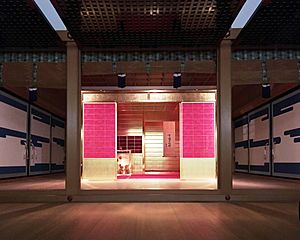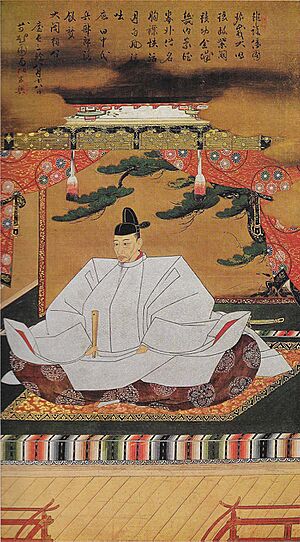Golden Tea Room facts for kids
The Golden Tea Room (called Ōgon no chashitsu in Japanese) was a special, portable tea room built in the late 1500s. It was made for Lord Toyotomi Hideyoshi, a powerful leader in Japan, to use for his tea ceremonies. This room was very unusual because it was covered in shiny gold! The original Golden Tea Room no longer exists, but several copies have been made so people can imagine what it was like.
Contents
A Golden History: Why Was It Built?
In the 1580s, Toyotomi Hideyoshi became very powerful in Japan. He won many battles against other warrior clans. This also gave him control over valuable metal mines, including gold mines.
Historians aren't sure exactly when the Golden Tea Room was built. We also don't know who made it or how much it cost. In 1585, Hideyoshi was given a very important job by the Emperor of Japan. He became the Imperial Regent, or kampaku.
The first time the Golden Tea Room is mentioned in history is in January 1586. Hideyoshi had the room brought to the Kyoto Imperial Palace. There, he used it to host the Emperor Ōgimachi. Most historians believe the room was finished just before this important visit. It was likely built especially for the Emperor, as Hideyoshi's first official guest as regent.
Famous Tea Gatherings
After this grand event, Hideyoshi often showed off his most prized tea tools inside the Golden Tea Room. He would give tours of the room to his important guests. The room was used again for a huge tea party called the Grand Kitano Tea Ceremony. This event took place on November 1, 1587, at the Kitano Tenmangū shrine in Kyoto.
The Golden Tea Room was designed to be moved. It traveled with Hideyoshi wherever he went. For example, it was moved from Osaka Castle to Hizen Nagoya Castle in 1592. From there, Hideyoshi launched his military campaigns in Korea. The room was probably also used in Fushimi Castle and his Jurakudai residence before it was eventually lost.
Replicas: Seeing the Golden Room Today
Many copies of the Golden Tea Room have been made over the years. You can find them in places like Fushimi Castle, Osaka Castle, and the MOA Museum of Art in Shizuoka. There's also a set of golden tea tools on display at the Kyoto City Archaeological Museum.
Crafting a Copy
The copy at the MOA Museum is thought to be one of the best. It was designed by an expert architect named Sutemi Horiguchi. About 50 kilograms (110 pounds) of gold were used for the tea tools in this room! These tools are copies of old bronze ones used by a famous tea school. Even the sliding doors have special silk fabric with paulownia flower patterns. These patterns were a favorite of Hideyoshi.
Another impressive copy was made by a master goldsmith from Tokyo. He followed old records from people who saw the original room. This copy is about 2.5 meters (8.2 feet) tall and 2.7 meters (8.9 feet) wide. It used 200-year-old Japanese cypress wood and 15,000 sheets of 23-karat gold leaf. That's about 26 kilograms (57 pounds) of gold! The gold was carefully applied by hand. This room took about eight months to build. All the tea tools, like the kettle and bowls, were also made of pure gold.
In 2022, the Saga Prefectural Nagoya Castle Museum also opened its own Golden Tea Room copy. It cost about 55 million Japanese yen to create.
What the Golden Tea Room Looked Like
We know what the Golden Tea Room looked like thanks to old writings. These records were kept by nobles, warriors, tea masters, and even Jesuit missionaries who saw the room.
The room was built from Japanese cypress wood, bamboo, reeds, and silk. It was designed to be taken apart and packed into crates. This made it easy to transport and set up again wherever Lord Hideyoshi wanted it. The room was probably about the size of three tatami mats. That's about 2.86 meters (9.4 feet) by 5.73 meters (18.8 feet).
Golden Details
The room's design was like a standard tea room. It had flat walls, simple rectangular pillars, and a flat ceiling. It also included a tokonoma alcove, which is a special display area. The Golden Tea Room was usually set up inside a larger room in a castle or home.
What made it unique was the gold! Every surface inside and outside the room was covered in gold leaf. This included the shōji sliding doors. The sliding doors even had delicate silk fabric on their latticework. The tatami mats on the floor were covered with a deep red felt or fabric. Almost all the tea tools, like the bowls and kettle, were made of gold or covered in gold. Only the whisk and the cloth were not gold.
A Room of Power and New Style
The Golden Tea Room was built to impress guests. It showed off the great power and wealth of Lord Hideyoshi. This was quite different from the simple, natural style of tea rooms favored by his tea master, Sen no Rikyū. Some people even think Rikyū might have helped design the golden room. Its extreme richness was very unusual and went against the idea of wabi-sabi, which values simplicity and imperfection. However, the room's clean lines and simple shape could still be seen as part of traditional design. We don't know exactly how much Rikyū was involved, but he was present many times when tea was served in the room.
Hideyoshi rose from a humble background to become the most powerful person in Japan. This was a new thing in Japanese history. Even though there was still fighting, Japan was starting to move away from the violent Sengoku period. As the old ways changed, so did tastes in art. Many warriors from outside the capital city preferred art that showed their strong character.
A new style began to appear, using more colors, patterns, and gold. This started even before Hideyoshi, under his predecessor Oda Nobunaga. This new style became a key part of the Azuchi–Momoyama period. The Golden Tea Room was a perfect example of this new taste. It was truly unique in the history of the Japanese tea ceremony.
The Golden Tea Room in Movies and Books
The Golden Tea Room has appeared in popular culture:
- It is shown in a scene in the 1962 movie Love Under the Crucifix.
- The 1989 film Rikyu shows Hideyoshi serving tea to the emperor in the room. It also explores the complex relationship between Hideyoshi and his tea master.
- The Japanese manga and anime series Hyouge Mono also features the Golden Tea Room in its story.
Images for kids





